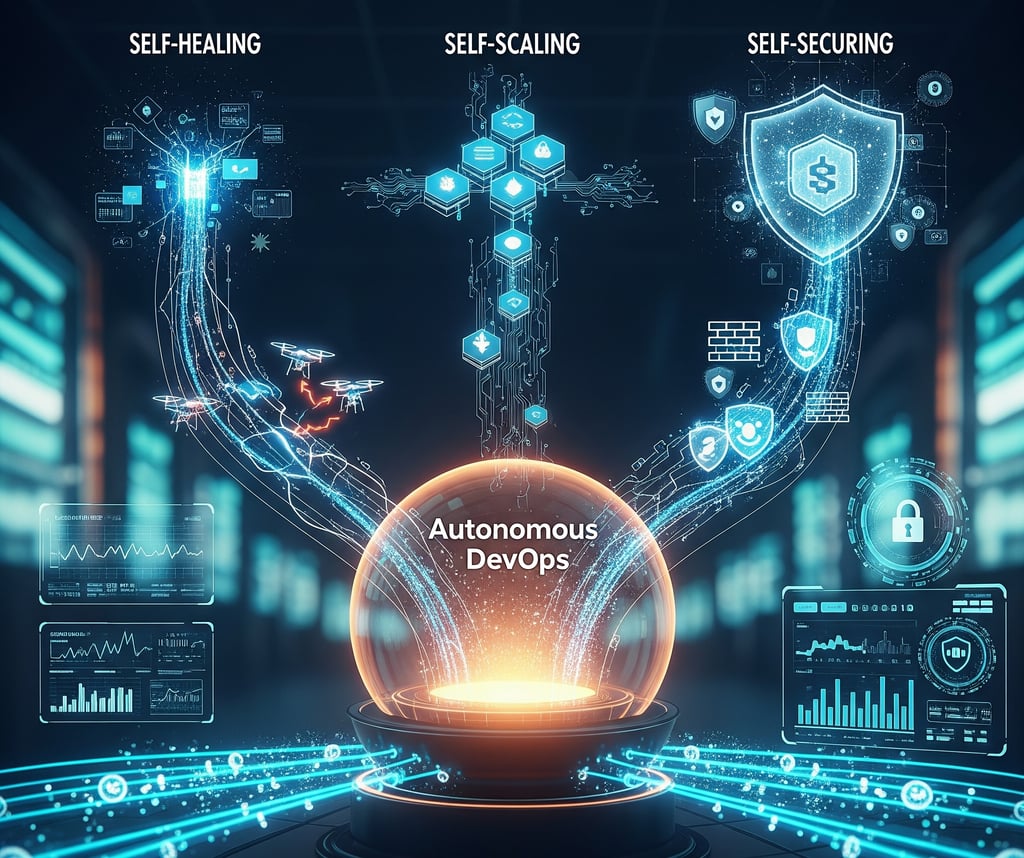The Future of Autonomous DevOps: Self-Healing, Self-Scaling, Self-Securing Systems
We’ve all heard about self-driving cars. But what about self-driving infrastructure? Imagine a world where your systems heal themselves after failures, scale automatically with precision, and secure themselves against emerging threats—without human intervention. This is not science fiction. This is the future of Autonomous DevOps.
Voruganti Kiran Kumar
5/21/20242 min read


We’ve all heard about self-driving cars. But what about self-driving infrastructure? Imagine a world where your systems heal themselves after failures, scale automatically with precision, and secure themselves against emerging threats—without human intervention. This is not science fiction. This is the future of Autonomous DevOps.
Why Autonomous DevOps?
Traditional DevOps has already transformed software delivery, but it still requires:
Constant human monitoring
Manual intervention during crises
Painstaking fine-tuning of resources
Autonomous DevOps takes the next leap: embedding AI-driven intelligence at every stage so that systems can adapt, optimize, and protect themselves in real-time.
The Three Pillars of Autonomous DevOps
1. Self-Healing Systems
Definition: Systems that detect failures, isolate the problem, and automatically remediate.
Examples:
Auto-restarting crashed containers.
Rolling back deployments when error rates spike.
Healing database clusters without downtime.
Impact: Reduces MTTR (Mean Time to Recovery) from hours to minutes—or even seconds.
2. Self-Scaling Systems
Definition: Workloads that anticipate demand and scale proactively—not reactively.
Examples:
AI models predicting Black Friday spikes and pre-scaling resources.
Edge systems distributing workloads dynamically based on latency predictions.
Impact: Eliminates over-provisioning, saves costs, and ensures seamless user experiences.
3. Self-Securing Systems
Definition: Infrastructure that continuously defends itself from threats.
Examples:
AI detecting unusual login behaviors and triggering automated quarantines.
Zero-trust frameworks enforced dynamically with policy-driven controls.
Impact: Creates an immune system for your tech stack, reducing breach risks.
How Close Are We Today?
Kubernetes + AI controllers already offer self-healing at the cluster level.
Predictive autoscaling is used in hyperscaler environments like AWS and Azure.
AI-driven intrusion detection is advancing rapidly with anomaly detection models.
We’re not fully autonomous yet, but the building blocks are in place.
The Challenges to Overcome
Trust and Transparency
Can organizations trust an AI to reboot their production database?
Explainability will be critical to adoption.
Complexity of Systems
Autonomous systems need visibility across apps, infra, and networks.
Today, silos still block full autonomy.
Ethics and Accountability
Who’s accountable if an AI makes a poor scaling decision?
Governance models must evolve.
Cost of Implementation
Building AI pipelines for DevOps requires upfront investment.
But the ROI in reduced downtime and optimized ops is enormous.
The Roadmap to Autonomous DevOps
Phase 1: Assisted Intelligence
AI suggests fixes, humans approve.
Phase 2: Semi-Autonomous
AI acts in low-risk cases, seeks approval for high-risk changes.
Phase 3: Fully Autonomous
AI governs full-stack operations with real-time auditing and reporting.
The Business Case for Autonomous DevOps
Downtime costs → $300k+ per hour for enterprises. Self-healing can slash this.
Scaling efficiency → Predictive scaling reduces wasted cloud spend by 20–40%.
Security → Real-time AI-driven defense reduces breach recovery costs (often millions).
For organizations, Autonomous DevOps is not just futuristic—it’s a competitive necessity.
The Role of Engineers in an Autonomous Future
Contrary to fears, Autonomous DevOps will not eliminate engineers—it will elevate them.
Engineers will design guardrails and governance.
Focus will shift from “firefighting” to innovation and architecture.
Human creativity will guide the ethical use of automation.
Final Thoughts
The future of DevOps is not human vs. machine—it’s human + machine.
Machines will monitor, scale, heal, and secure.
Humans will lead, innovate, and ensure responsibility.
Autonomous DevOps is the self-driving car moment for technology operations. The organizations that embrace it early will lead in reliability, efficiency, and trust.
Call to the Community
Do you believe full autonomy in DevOps is achievable in the next decade? Or will humans always need to remain in the loop?
I’d love to hear your thoughts—because shaping this future requires voices from across the global tech community.